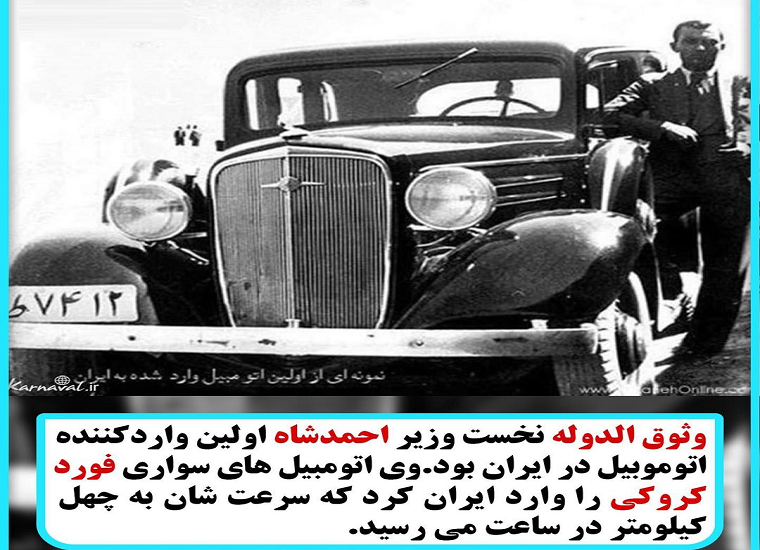 At the beginning of the arrival of cars in Iran, there was no news about dynamos and batteries in them and they had to be turned on with the handle. These cars did not have electric horns and their lights were lit with matches. They did not have any heating or cooling systems, and they caused trouble for their passengers in winter and summer. There was no asphalt road at that time and the alleys were so narrow that they took the driver's life to cross them. The price of each car, depending on its type and brand, was between 300 and 350 tomans, of which one-fifth was received as an advance and the buyer paid the rest in the long run. The most expensive cars were the first Graham Peach, which cost 2,500 tomans and came with a large number of spare parts, two spare rings, a box of wrenches, an air pump, and a mobile light. Prizes such as watches or cushions, lighters, leather jackets, cigarette butts, and beads and keychains were intended for buyers, among which leather or raincoats were the most popular because drivers wore these leather or raincoats. Wearing pilot helmets and wearing smoked glasses, they pretended to be pilots and sold their pride to others.
At the beginning of the arrival of cars in Iran, there was no news about dynamos and batteries in them and they had to be turned on with the handle. These cars did not have electric horns and their lights were lit with matches. They did not have any heating or cooling systems, and they caused trouble for their passengers in winter and summer. There was no asphalt road at that time and the alleys were so narrow that they took the driver's life to cross them. The price of each car, depending on its type and brand, was between 300 and 350 tomans, of which one-fifth was received as an advance and the buyer paid the rest in the long run. The most expensive cars were the first Graham Peach, which cost 2,500 tomans and came with a large number of spare parts, two spare rings, a box of wrenches, an air pump, and a mobile light. Prizes such as watches or cushions, lighters, leather jackets, cigarette butts, and beads and keychains were intended for buyers, among which leather or raincoats were the most popular because drivers wore these leather or raincoats. Wearing pilot helmets and wearing smoked glasses, they pretended to be pilots and sold their pride to others.
The Arrival Of The First Car In Iran
 At the beginning of the arrival of cars in Iran, there was no news about dynamos and batteries in them and they had to be turned on with the handle. These cars did not have electric horns and their lights were lit with matches. They did not have any heating or cooling systems, and they caused trouble for their passengers in winter and summer. There was no asphalt road at that time and the alleys were so narrow that they took the driver's life to cross them. The price of each car, depending on its type and brand, was between 300 and 350 tomans, of which one-fifth was received as an advance and the buyer paid the rest in the long run. The most expensive cars were the first Graham Peach, which cost 2,500 tomans and came with a large number of spare parts, two spare rings, a box of wrenches, an air pump, and a mobile light. Prizes such as watches or cushions, lighters, leather jackets, cigarette butts, and beads and keychains were intended for buyers, among which leather or raincoats were the most popular because drivers wore these leather or raincoats. Wearing pilot helmets and wearing smoked glasses, they pretended to be pilots and sold their pride to others.
At the beginning of the arrival of cars in Iran, there was no news about dynamos and batteries in them and they had to be turned on with the handle. These cars did not have electric horns and their lights were lit with matches. They did not have any heating or cooling systems, and they caused trouble for their passengers in winter and summer. There was no asphalt road at that time and the alleys were so narrow that they took the driver's life to cross them. The price of each car, depending on its type and brand, was between 300 and 350 tomans, of which one-fifth was received as an advance and the buyer paid the rest in the long run. The most expensive cars were the first Graham Peach, which cost 2,500 tomans and came with a large number of spare parts, two spare rings, a box of wrenches, an air pump, and a mobile light. Prizes such as watches or cushions, lighters, leather jackets, cigarette butts, and beads and keychains were intended for buyers, among which leather or raincoats were the most popular because drivers wore these leather or raincoats. Wearing pilot helmets and wearing smoked glasses, they pretended to be pilots and sold their pride to others.
 newsoholic Time to become News Oholic!
newsoholic Time to become News Oholic!